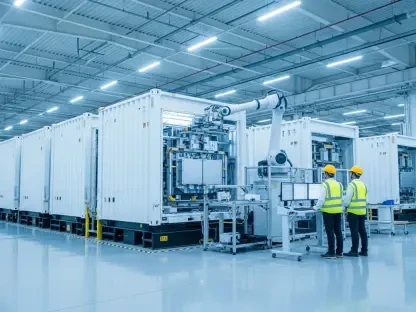The development of nuclear batteries in Japan and South Korea represents a significant leap in energy storage technology, potentially heralding a new era for energy solutions. These batteries may address one of the most critical issues of our time: the instability of renewable energy sources. As we delve into the innovations, we encounter the pioneering work in uranium rechargeable batteries by the Japan Atomic Energy Agency and the betavoltaic battery development by South Korean researchers. These advancements could provide sustainable and reliable energy storage solutions capable of managing supply fluctuations inherent in renewable sources like solar and wind power.
Pioneering Uranium Rechargeable Batteries in Japan
The Japan Atomic Energy Agency (JAEA) has innovated the world’s first uranium rechargeable battery, using depleted uranium (DU) as the negative electrode and iron as the positive electrode. This prototype operates at a voltage similar to traditional alkaline batteries, showcasing a novel application of uranium beyond its conventional uses. This battery’s development also addresses environmental concerns, as repurposing the significant amounts of DU stored globally can mitigate storage challenges. The prototype has demonstrated stability, having undergone multiple charging and discharging cycles without significant performance degradation, which marks a substantial advancement in energy storage technology.
The historical backdrop to the uranium battery concept dates to the early 2000s, where it was proposed but lacked empirical data on performance. The breakthrough by JAEA is not just technical but also addresses larger environmental and energy storage issues. With approximately 16,000 tonnes of DU stored in Japan and roughly 1.6 million tonnes globally, repurposing DU in batteries could potentially mitigate some of the storage challenges. JAEA is focusing on increasing the uranium rechargeable battery’s capacity, exploring ways to enhance the amount of electricity it can store. This involves investigating the optimal materials for electrodes and membranes and increasing the electrolyte’s circulating amount and the concentration of uranium and iron within it.
South Korea’s Betavoltaic Battery Breakthrough
South Korean researchers, led by Professor Su-Il In from the Daegu Gyeongbuk Institute of Science & Technology, have developed a betavoltaic battery using the carbon-14 isotope, promising an extraordinarily long lifespan without recharging. Radiocarbon’s exclusive emission of beta rays makes it safer and more practical compared to other radioactive materials. The battery’s design includes a titanium dioxide-based semiconductor sensitized with a ruthenium-based dye, where a citric acid treatment strengthens the bond between the titanium dioxide and the dye. Beta rays emitted from radiocarbon initiate cascades of electron transfers, generating an electron avalanche that is effectively collected by the titanium dioxide, producing electricity.
Radiocarbon was chosen because it emits solely beta rays, making it safer and easier to handle compared to other radioactive materials. Additionally, being a by-product of nuclear power plants, radiocarbon is inexpensive and recyclable. The battery’s design incorporates radiocarbon on both the anode and cathode, increasing beta-ray generation and minimizing energy loss from radiation. During demonstrations, the prototype successfully converted beta rays into usable electricity, though the performance still lags behind conventional lithium-ion batteries. To enhance this performance, further optimization of the beta-ray emitter’s shape and development of more efficient beta-ray absorbers are necessary.
Addressing Renewable Energy Challenges
Both Japan and South Korea aim to solve the intermittency issues inherent in renewable energy sources like solar and wind power. Efficient and high-capacity storage solutions are imperative for ensuring a consistent and reliable energy supply. The ongoing development efforts signify a strategic shift towards using nuclear materials for battery technology. This approach aims to create sustainable energy storage that can stabilize the grid amidst fluctuating renewable energy generation.
Common themes across both Japanese and South Korean developments include the need for long-lasting, stable energy storage solutions driven by the rise of renewable energy sources. Both projects shine a light on the overarching trend of leveraging nuclear material for battery technology—a marked shift from their traditional uses in power generation. There’s a clear consensus that addressing the intermittency of renewable sources requires innovative energy storage solutions.
Technical Hurdles and Future Directions
Japan’s uranium batteries face the challenge of scaling up their capacity. Enhancing the materials and configuration of electrodes and membranes remains a key focus to achieve higher electricity storage. The challenge lies in verifying the long-term reliability and safety of these batteries when used on a larger scale. Addressing these issues could make uranium batteries a viable solution for stabilizing renewable energy sources and providing consistent power supply.
For South Korea’s betavoltaic batteries, improving the shape of the beta-ray emitter and developing more efficient absorbers are crucial next steps. These enhancements are intended to optimize the energy conversion process and bring the technology on par with current battery standards. The focus on increasing conversion efficiency is essential for making these batteries competitive with existing solutions in the market. As these technologies evolve, they could provide a reliable alternative for energy storage in critical applications.
The Global Impact
The development of nuclear batteries in Japan and South Korea marks a significant advancement in energy storage technology, potentially ushering in a new era for energy solutions. These innovative batteries could tackle one of today’s most pressing issues: the intermittency of renewable energy sources. Exploring these breakthroughs, we find notable contributions like the uranium rechargeable batteries being pioneered by the Japan Atomic Energy Agency and the betavoltaic batteries being advanced by South Korean researchers. Both technologies hold the promise of offering sustainable and dependable energy storage solutions, which are crucial for managing the supply fluctuations that are typical in renewable energy sources like solar and wind power. These new battery types could revolutionize how we store and use energy, ensuring a steadier and more reliable supply even when renewable sources are inconsistent. This leap in technology could be essential for a future that increasingly relies on renewable energy.









